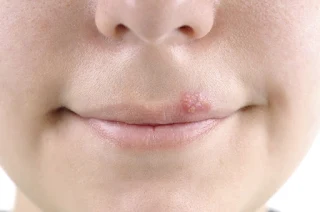Cold Sore
Introduction
A cold sore (herpes labialis) is usually a painful, self-limiting infection of the lips, cheeks or nose or oropharyngeal mucosa, caused by the herpes simplex virus type 1 (HSV-1).
NOTE: HSV type 2 is most commonly implicated in genital lesions.
The infection is spread by viral shedding into saliva and results from direct mucous membrane contact (e.g. kissing) at sites of abraded skin between an infected and uninfected individual.
- Risk of transmission is highest during the first 1-4 days of symptoms and people should be advised not to kiss others.
- Once contracted, the person will have the HSV-1 virus for lifetime. Hence, recurrence is common.
Triggering factors include stress, ill health, sunlight, winter weather, viral infection (e.g. the common cold) and menstruation.
Clinical Features
Patients typically experience prodromal symptoms of itching, burning, pain or tingling symptoms 6 to 48 hours before skin eruption.
The lesions appear as blisters and vesicles with associated redness on the outer lip. These crust over, usually within 24 hours, tend to be itchy and painful, and might bleed.
Lesions spontaneously resolve in 7 to 10 days; therefore most outbreaks last 14 days from the recognition of prodromal symptoms to the resolution of lesions.
NOTE: If a sore keeps on returning in the same place in a similar way, then it is likely to be a cold sore.
Differential Diagnosis
Angular cheilitis is a common, non-contagious, inflammatory condition affecting the corners of the mouth.
- It is more common in patients who wear dentures.
- The corners of the mouth become cracked, fissured and red. The lesions can become boggy and macerated, and are slow to heal because movement of the mouth hinders healing of the lesions.
- It is painful, but generally does not itch or crust over, as is typical with cold sores.
- In many cases, no treatment is needed and angular cheilitis resolves by itself.
Eczema herpeticum warrants immediate medical attention.
- Patients with atopic eczema are very susceptible to herpetic infection and may show an abnormal response to the virus with widespread lesions and sometimes involvement of the central nervous system.
Indicative of Referral
Duration >14 days
- Unlikely to be cold sores.
Cold sores located in the mouth or close to the eye
- Outside scope of community pharmacy.
Lesions that spread away from the lips and onto the face
- Impetigo more likely.
Patients on chemotherapy, oral corticosteroids or drugs for HIV
- May be susceptible to more severe infection.
OTC Medications
Treatment with topical acyclovir is of most value if started in the course of the infection (during the prodromal phase).
- Acyclovir cream should be applied four hourly during waking hours (approximately five times a day) to the affected area for 5 days. If healing is not complete, treatment can be continued for up to 5 more days, after which medical advice should be sought if the cold sore has not resolved.
- It reduces time to healing by 0.5 to 1 day and reduce pain experienced from the lesion.
- Once the lesion has appeared, evidence of effectiveness is less convincing.
Local anaesthetics (e.g. lidocaine) or analgesia (paracetamol or ibuprofen) may help with discomfort and pain.
Hydrocolloid gel patch is applied as soon as symptoms start and replaced as needed.
- Limited evidence for efficacy in cold sores.
Complementary Therapies
Lysine has been studied for the prevention and treatment of herpes infections and cold sores, but evidence is conflicting.
- Review of the current literature suggests recurrence rates can be decreased with daily doses exceeding 3 grams.
Balm mint extract and tea tree oil applied topically may have an effect on pain, dryness and itching.
- However, there is insufficient evidence to assess whether they have an effect on healing, time to crusting, severity of an attack or rate of recurrence.
For those patients in whom the sun triggers cold sore, a sunscreen would be the most effective prophylactic measure.
Summary
Patients with severe infection, or who are immunocompromised, are usually prescribed oral antiviral therapy by a doctor.
- Some patients who get frequent (>4 times per year), severe cold sores either take oral antivirals long term (prophylaxis) or are given a supply to start at the onset of symptoms.
External Links
- American Academy of Dermatology Association - Cold Sores
- Antiviral activity of Australian tea tree oil and eucalyptus oil against herpes simplex virus in cell culture, 2001
- Natural remedies for Herpes simplex, 2006
- Randomized clinical study comparing Compeed cold sore patch to acyclovir cream 5% in the treatment of herpes simplex labialis, 2008
- Interventions for prevention of herpes simplex labialis (cold sores on the lips), 2015
- Lysine for Herpes Simplex Prophylaxis: A Review of the Evidence, 2017
- By the way, doctor: Does lysine prevent cold sores?, 2019
- Clinical Study on the Effectiveness of Three Products in the Treatment of Herpes Simplex Labialis, 2020

Comments
Post a Comment